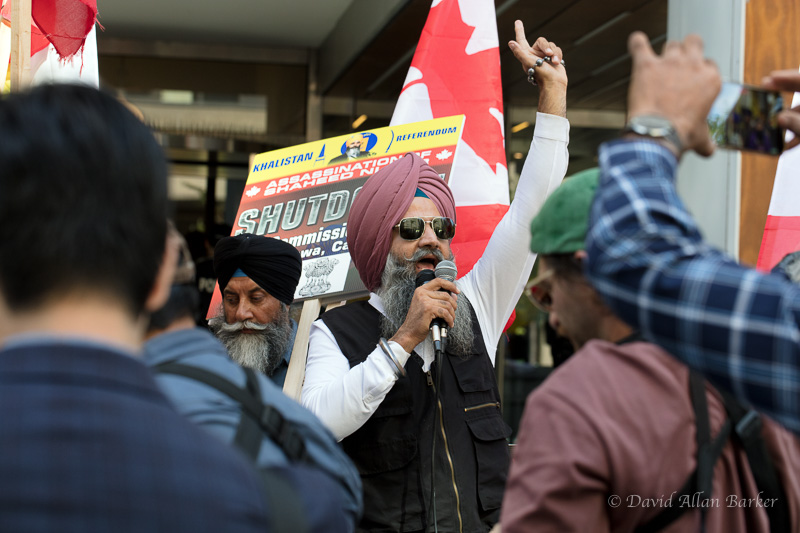I suspect it’s typical of most people that when they hear of an emerging conflict in the news, they pass over the headlines and move on to something else unless the conflict personally affects them. My suspicion comes from personal experience. For example, in 2011, when civil war broke out in Syria, I told myself I should be deeply concerned, but it was so complex, with so many factions, and interventions by so many external states and organizations, that I soon lost the thread and gave up trying to make sense of it. It was almost like watching a Netflix series on TV and missing an episode while everyone else in the room has kept up to date. Maybe it would have been different if I had a personal connection, a friend or relative, say, who was directly affected by the conflict. Then, I might feel an emotional investment in the situation and try to keep up. But it’s all too easy to dismiss the news as an abstraction happening “over there” to people I don’t know or understand.
Assassination of Hardeep Singh Nijjar
It’s tempting for me to take the same tack in the emerging diplomatic row between Canada and India. On September 18th, Justin Trudeau announced there was credible evidence that the June 18th murder of a Canadian citizen, Hardeep Singh Nijjar, outside a Sikh temple in Surrey, B.C. was an extrajudicial killing orchestrated by people acting on behalf of the Indian state. Naturally, Narenda Modi denied the allegations. India’s Ministry of External Affairs issued a statement which included the following as reported by the CBC: “Such unsubstantiated allegations seek to shift the focus from Khalistani terrorists and extremists, who have been provided shelter in Canada and continue to threaten India’s sovereignty and territorial integrity.” Curiously, the statement does precisely what it claims the Canadian allegations do, namely it shifts focus. It distracts us from the issue at hand by engaging in severe case of whataboutism. It further asserts India’s right to safeguard its sovereignty without answering the allegation that it has violated Canada’s sovereignty. Taken together, these two elements of the statement produce something like the following answer: “We didn’t do what you say we did, but even if we did it, that’s okay because the person you say we did it to is a really bad man.”
As a Canadian citizen, I prick up my ears when I hear allegations of an extrajudicial killing on Canadian soil, so I want to learn more. However, when I do some personal digging, I discover that the situation is so complicated and fraught with historical baggage that I feel tempted (as I did 12 years ago with the story of the Syrian civil war) to gloss over the headlines and move on to the crossword. However, this particular news item intrudes upon my thoughts and won’t leave me alone.
There is a practical reason why this story won’t leave me alone. Each morning as I eat breakfast, I stare into the offices of Toronto’s Indian consulate. Ah, one of the joys of living in a downtown condo. Predictably, the consulate is the site of frequent protests. In beforetimes, the protesters gathered in solidarity with Indian farmers whose livelihoods were threatened by proposed legislation from the Modi government. Essentially, Narenda Modi was trying to do to Indian farmers what Margaret Thatcher once did to British coal miners, as if to confirm the adage that neoliberalism’s chief export is its mistakes. In the name of market liberalization, the proposed legislation would dismantle a system that allowed small farmers to sell produce to a network of markets and allow (compel?) them instead to sell directly to large institutional purchasers. The problem is that the new arrangement would introduce a huge disparity of bargaining power making it difficult for farmers to earn a livelihood. Ultimately, the protests were successful; Modi announced the formal repeal of the laws on December 1st, 2021. Nevertheless, this episode signals something (although not everything) about Modi’s politics.
Despite the repeal, the protests outside my front door never stopped. Instead of orange, white and green flags, I saw Sikhs gathering with yellow flags displaying the word “Khalistan.” That was my introduction to the fact that many (most?) Sikhs want to establish an independent state in the Punjab region called Khalistan. That call is particularly loud in Canadian cities because it turns out that Canada is home to the largest Sikh population outside India. Modi maintains that, by definition, anyone who promotes the idea of an independent Punjab, anyone who even breathes the word Khalistan, must be a terrorist, or must support terrorism. Hence the statement from the Ministry of Foreign Affairs which effectively accuses Canada of harbouring terrorists. However, and I think we need to be excruciatingly blunt here, Modi is not the leader of a democratic state. India may look like a democratic state, and it certainly wants to hobnob with other democratic states through the G20. But Modi functions more like an authoritarian figure and aspires for India to become a Hindu nation. India’s Ministry of External Affairs may point its finger at Sikhs and decry extremists but Modi promotes his own kind of extremism where the endgame is a theocracy rooted in religious fundamentalism that offers no place for minority interests. In the long run, India may have no place for Sikhs in the same way that Russia has no place for Ukrainians.
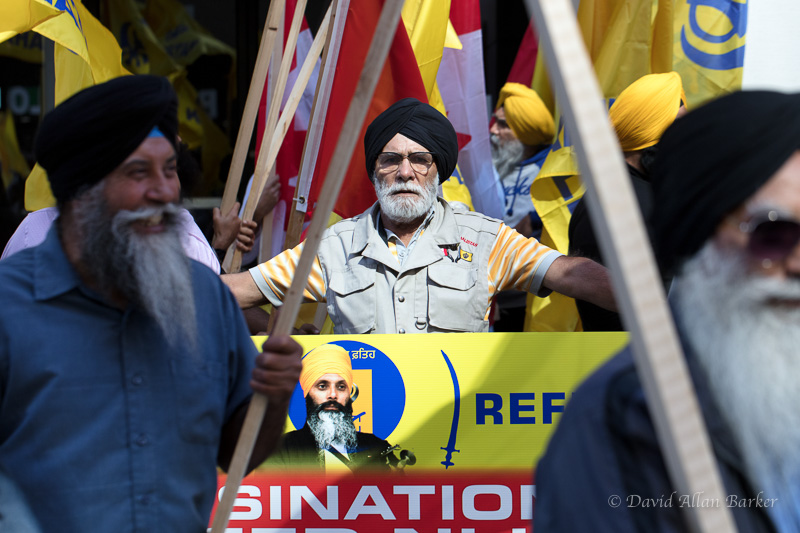
Air India Flight 182
Inevitably, critics of the Khalistan movement point to the bombing of Air India flight 182 on June 23rd, 1985. At that time, I happened to be a student working for the summer at a law firm which represented Air India’s interests in Canada. I remember the mood on the following morning when I arrived at the office, the absolute pall that had settled over everyone and everything. It would subsequently prove to be the worst act of terrorism ever perpetrated on Canadian soil.1 Although my summer job gave me no special access or knowledge, it did lodge in my memory the date June 23rd, 1985 as a moment of grave historical significance. An official investigation tied the bombing to Babbar Khalsa, a militant organization supporting the Sikh separatist movement (possibly in retaliation for Operation Blue Star during which Indian Troops besieged the Golden Temple in Amritsar, in Punjab, resulting in more than a 1,000 deaths). However, Canadian authorities were unable to obtain convictions except in the case of one person, Inderjit Singh Reyat, who pleaded guilty to manslaughter for manufacturing the bomb.
I have subsequently visited the memorial commemorating the site of the downed flight. My wife and I were on a cycling tour with friends through West Cork in Ireland and we rode our bicycles into the village of Ahakista through horizontal rain and gale force winds, the remnants of Hurricane Maria which, earlier in its journey across the Atlantic, had been a category 5 storm. We paused at the site, gazing out across the water. The weather had merged sea and sky and it reminded me of the memorial at Peggy’s Cove for Swiss Air flight 111 which includes the phrase “they have been joined to the sea and the sky.” As we were leaving, a coach arrived and people on a tour from India began to exit the bus, blown back by the fierce wind even as they stepped onto the ground. The scene had about it a sense of soulful desolation. Indian nationals in jeans and sweatshirts soaked to the skin while we stood by in our waterproof cycling gear, water streaming over our eyes, indistinguishable from tears.
The Mirror World
At this point, the conversation deserves a useful analytical tool courtesy of Naomi Klein’s just published book, Doppelganger: A Trip Into The Mirror World. In particular, she gives space to a three-part habit that is to authoritarian leaders as cocaine to an addict, namely mirroring, deflection, and projection. I commend her analysis to readers for deeper study and apologize in advance for my gross oversimplifications. Nevertheless, let’s step into the mirror world, shall we? In brief, leaders of an authoritarian bent resort to these habits to evade accountability with the result that they effectively sabotage efforts to engage in meaningful public conversation. We can see all of this at work in the statement issued by India’s Ministry of External Affairs.
Mirroring: Canada says it has proof that the Modi government has violated Canadian sovereignty and engaged in a state-sanctioned killing. The Modi government responds by flipping the narrative around, offering the world a reality-distorting narrative that is the mirror image of the Canadian account. In fact, according to India, it is Indian sovereignty that is at stake and it is Canada that has engaged in terrorist activities by harbouring people who want to bring them down.
Deflection: Klein’s three-pronged strategy is most effective when the person wielding the trident crafts a narrative that has an element of truth to it. Or “truthiness” as Stephen Colbert might put it. In this instance, it’s absolutely true that historically the Sikh independence movement has been associated with acts of violence. There’s nothing quite like a narrative of victimhood to galvanize people (or nations) against an alleged aggressor. Look at all the bad things Sikhs have done, says Modi (but let’s nevermind that he’s promoting a Hindu nationalist agenda whose aim is the extermination of religious minorities).
Projection: Ascribe to your opponent traits you yourself possess. Observers of the Trump presidency passed four years engaged in a clinic on projection. In the case of Modi, it’s fair to say that any accusations he makes can be taken as a list of the crimes he’s already committed. He fears the Sikh threat because he’s afraid they’ll do to him what he’s already been doing to them. And as the 1984 assassination of Indira Gandhi by her two Sikh bodyguards illustrates, Modi is not invulnerable.
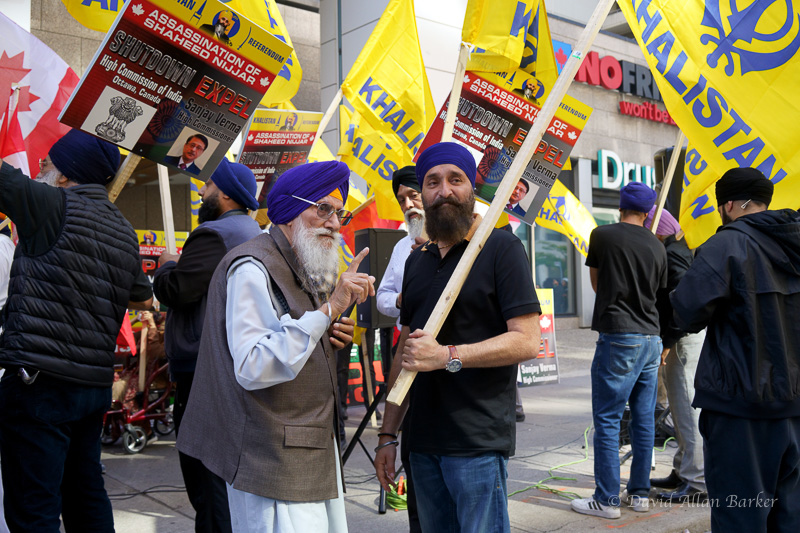
A Protest
On Monday (September 25th, 2023), a fresh protest gathered steam on my doorstep, this time with renewed energy thanks to Trudeau’s allegations which lend credence to the idea that Modi’s anti-Sikh sentiments might in fact have real world consequences. When I have a camera in hand, I shoot first, think later. So I milled around the protest, gathering images, and left the analysis for another time. There was a discreet police presence on site, both local Toronto police and RCMP officers. I even noted four mounted police proceeding south down Sherbourne across Bloor Street. However, I inferred from the relatively sparse numbers and relaxed attitude of those present that they weren’t anticipating trouble.
The first thing I noted about the crowd of protesters was that it skewed to older men. They had a microphone and loudspeakers and passed the mic from person to person so they could take turns speaking. At one point, a millennial took the mic and address the crowd in English. The speaker began by thanking the Canadian government and Five Eyes nations for gathering intelligence that confirmed what the Sikh community had been saying all along. He thanked the government for the courage to say aloud what needed to be said. Then the speaker shifted to another topic: the Air India bombing. He called on the Canadian government to reopen the investigation into the incident because, just as the Sikh community had always known that the Indian government was behind the murder of Hardeep Singh Nijjar, so it also knew that the government was behind the downing of flight 182. It was a false flag operation aimed at smearing the Sikh separatist movement.
Personally, I’m not about to enter a debate about Air India flight 182. Just as I’m confident that Canadian intelligence has credibly fingered the Indian government for an extrajudicial killing, I’m likewise confident Canadian intelligence has credibly fingered Sikh extremists as the perpetrators of the Air India bombing. But in the context of this protest, it is interesting to observe that a younger participant—someone not yet born, or barely in diapers, when the plane went down—resorts to conspiratorial thinking in order to shield the Sikh community from allegations that it has a history of militant extremism. The impulse is understandable. Here is an articulate young man, obviously well educated, probably a sensitive soul, who may be experiencing cognitive dissonance: there is an irresolvable conflict between the aspirations of his faith community and the practical measures it may engage to realize those aspirations. The world demands a purity of purpose and has no tolerance for the messiness of lived experience. It is worth noting that the Sikh community is trying to answer that demand by holding a referendum. It proceeds by a peaceful democratic process and hopes that lends the movement a measure of moral authority.
It is unfortunate that Canadian prosecutors failed obtain convictions of the principal architects of the Air India bombing as that failure injects an element of uncertainty into the historical record and renders it more susceptible to conspiracist interpretations. Meanwhile, the older men at the protest don’t appear to need the comfort a good conspiracy theory would offer. One wears a vest with the silhouette of an automatic weapon emblazoned on the back. He gives the impression that whatever cognitive dissonance he felt as a youth he left behind long ago. If militancy is what it takes, then that’s what he’ll give. (Apropos of nothing, I note that one of the older speakers is missing his index finger from the first knuckle.)
One of the lessons we learn from Klein’s analysis is that mirroring can happen in one and the same subject. We prefer to think in either/or terms. Either Sikhs in Canada are peaceful victims, or they are militant perpetrators. But not both. And yet the one is simply a distorted mirror image of the other, and both can operate in the same subject simultaneously. The young speaker wants to live in a world of perfect motivations, as do we all, but I’m reasonably certain that maturity will one day force that speaker to confront a different image of himself, one that grafts violent impulses onto a certain belief in the righteousness of his cause.
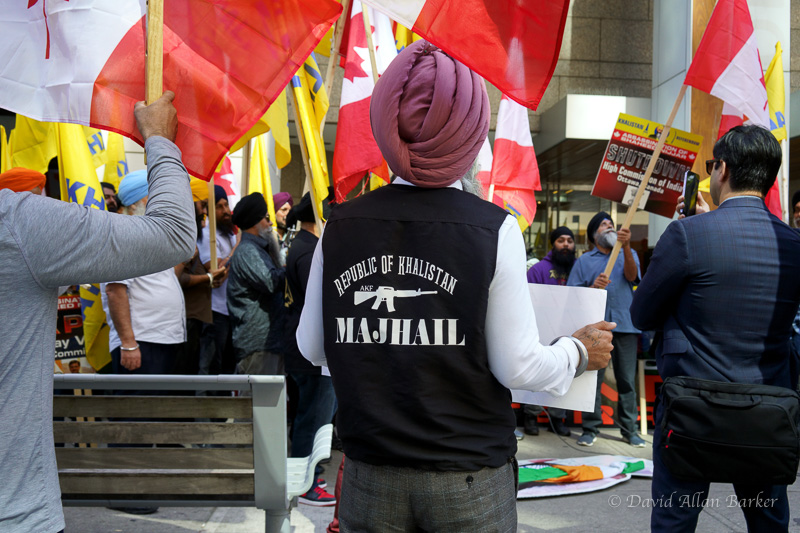
The Endgame
To bring this discussion to a close, I invite you to join me in a thought experiment. Imagine the Sikh diaspora votes to establish an independent Khalistan and the Indian government cedes lands in the Punjab region to satisfy the claim. What next?
Turning again to Naomi Klein, I refer you to her treatment of the Israel/Palestine conflict and offer it as a cautionary tale that might provide guidance as Sikhs pursue a similar arrangement. I don’t think it’s a surprise to learn that a liberal diaspora Jew has a few critical words for the state of Israel and its treatment of Palestinians in Gaza and in the West Bank. If she weren’t Jewish, then, for her criticism, she would be presumed to be an anti-Semite. Instead, she gets the honour of being branded a self-hating Jew. As you might be able to predict by now, she starts with the notion of mirroring. In its inception, the idea of Israel was sound: it would provide a safe haven for a singularly persecuted people. However, in its realization, Israel followed the settler colonist playbook that had been penned by so many Western European countries, starting with the assumption that they were establishing a new life in a terra nullius. Israel mirrors (by persecuting even as its first settlers were once persecuted). It deflects (by, for example, pointing out that it is a constitutional democracy which protects the rights of LGBTQ+ Israelis as if that’s somehow relevant to the conversation). And it projects (by automatically accusing its critics of engaging in hate speech). In effect, it has created a new class of victim, with a fresh identity born of that victimhood, and its own independence movement complete with ever escalating violence.
The Punjab region is no terra nullius. In fact, it’s home to a population roughly equal to one third of North America, most of it Moslem and Hindu. Imagine clearing out the entire eastern seaboard to make space for a new Sikh nation called Khalistan. That should give you a sense of the enormity of the project. And given Klein’s cautionary tale, it should also give you a sense of why any attempt to realize the project would be disastrous. It would produce more victims and more independence movements and more violence. The movement for an independent Sikh nation will never get anywhere until it demonstrates an unwavering commitment to justice, not only for itself, but a universal conception of justice for all peoples. While, as a theoretical matter, it might never succeed, it might still make some headway by addressing a single practical question: what to do about difference? In fact, we’d all be well advised to address that question on a daily basis. How do we live next to people who are not like us? How do we accord them the dignity to live into their culture and customs while not feeling threatened as we live into ours?
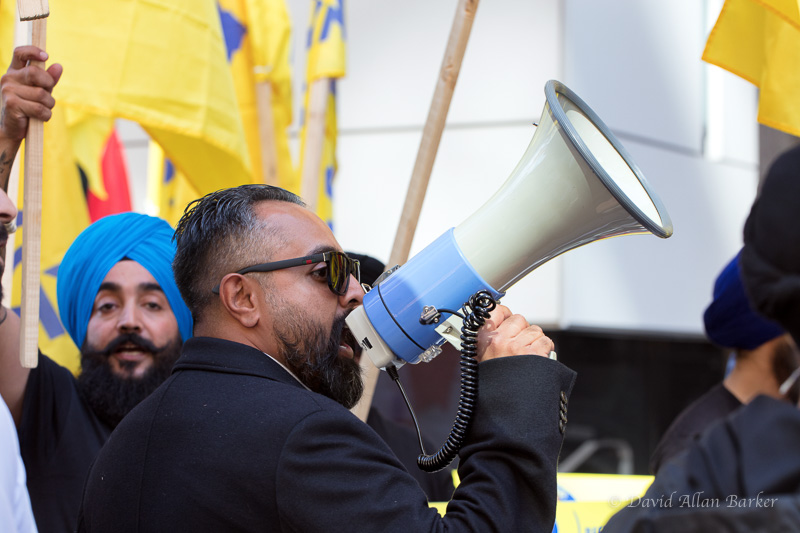
Note:
- This is a claim I found in Wikipedia but I suspect it may be contested by Indigenous historians. Nevertheless, it was an act whose extraordinary violence needs to be acknowledged. ↩︎
